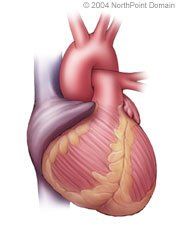Pulmonary Hypertension
Basic Facts
- Hypertension is high blood pressure that persists over time.
- Pulmonary hypertension is high blood pressure in the pulmonary arteries, which carry venous blood from the heart to the lungs for oxygenation, or in the pulmonary veins, which carry blood from the lungs to the heart.
- As blood pressure in the pulmonary arteries increases, the right side of the heart must work harder to pump blood into the lungs.
- Pulmonary hypertension may be caused by an underlying condition or for no clear reason.

Pulmonary hypertension includes conditions that raise the blood pressure in the pulmonary arteries, the vessels carrying blood from the heart to the lungs, or in the pulmonary veins, which carry blood from the lungs to the heart.
Pulmonary hypertension is chronic, beginning slowly and progressing. There is no cure for pulmonary hypertension, although it may be treated if caused by an underlying condition.
WHAT ARE THE SYMPTOMS?
In the early stages of pulmonary hypertension, people may experience no symptoms. As pulmonary hypertension progresses, symptoms may include:
- Dizziness;
- Fatigue; and
- Swelling in the feet or ankles.
In severe cases, pulmonary hypertension may cause fainting or cyanosis (blue-tinged skin), and when the heart must work harder to pump blood through the pulmonary arteries, heart failure may occur.
CAUSES AND RISK FACTORS
Primary pulmonary hypertension occurs when the arteries between the heart and the lungs are narrowed.
In secondary pulmonary hypertension, an underlying heart disease or chronic lung disease causes the condition. Underlying conditions that cause secondary pulmonary hypertension include:
- Chronic obstructive pulmonary disease;
- Interstitial lung disease;
- Congenital heart disease;
- Scleroderma;
- Pulmonary embolism;
- Valvular heart disease; and
- Congestive heart failure and cardiomyopathy.
DIAGNOSIS
One or more of the following diagnostic tests can confirm the diagnosis of pulmonary hypertension:
- Chest x ray;
- Echocardiography;
- Electrocardiography (ECG);
- Cardiac catheterization and angiography;
- Pulmonary function tests; and
- Pulmonary perfusion/ventilation scans.
TREATMENT APPROACH
For cases of secondary pulmonary hypertension, the physician will suggest treatments for the underlying condition. Since smoking causes some of the conditions that may lead to pulmonary hypertension, quitting smoking is an important first step.
Medications are the main therapy used. Some commonly prescribed drugs include:
- Diuretics;
- Calcium channel blockers;
- Epoprostenol;
- Anticoagulants.
Home oxygen therapy is prescribed for patients whose blood oxygen levels drop too low.
When other treatments are insufficient to keep a patient with pulmonary hypertension alive, a lung or heart-lung transplant may be necessary.
Copyright © 2017 NorthPoint Domain, Inc. All rights reserved.
This material cannot be reproduced in digital or printed form without the express consent of NorthPoint Domain, Inc. Unauthorized copying or distribution of NorthPoint Domain's Content is an infringement of the copyright holder's rights.
